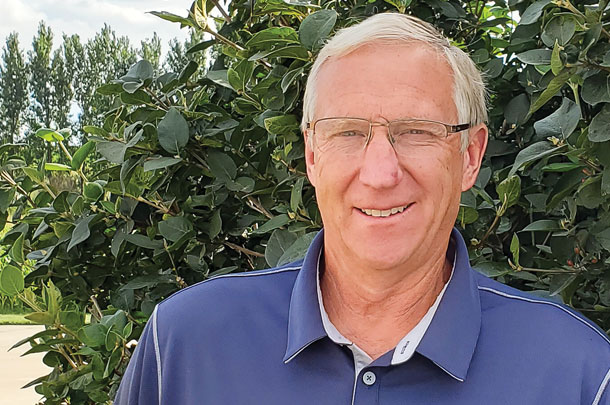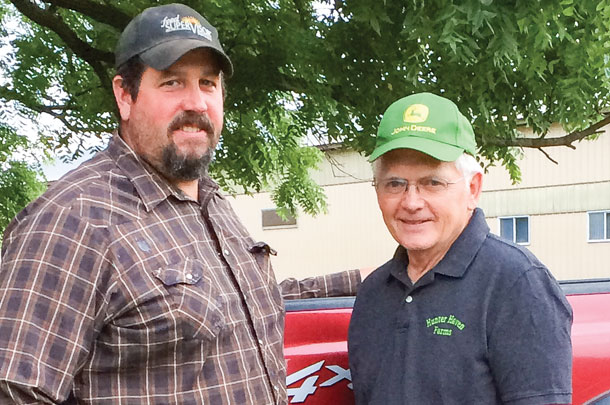Winding Meadows

In the spring of 2019, many dairy producers started opening up about how tough the previous year had been. Terry Van Maanen said he found reassurance during that time. “I didn’t feel so alone knowing I was not the only one struggling,” he said.
Although the dairy economy is tough, Van Maanen shared some tactics he feels have helped his dairy operation. He is the fourth generation to operate the family farm near Rock Valley, Iowa. He is currently expanding his herd from 1,200 to 1,600 cows to optimize the use of their double-20 parallel parlor. The rolling herd average is 28,000 pounds.
Knowing your operation’s numbers is important, and having a financial consultant who understands dairy is crucial, Van Maanen said. His financial consultant noticed that Winding Meadows’ breeding costs were higher than average.
Van Maanen said his operation does not use any conventional dairy semen. Heifers are bred a maximum of three times to sexed semen and, if they fail to conceive, they are put out with a bull. Higher-genetic-potential cows are chosen to be bred twice with sexed semen, then twice to beef bulls – and if they fail to conceive, they are eventually culled.
Working with Farm Credit Services, Van Maanen tracks his borrowing base monthly. Borrowing base is the total amount of collateral against which a lender will lend funds to a business. It shows a maximum cap on how much asset-based debt a farm can obtain. He said he feels tracking his borrowing monthly helps him to know if he is moving in the right direction. “It gives me an alert when my numbers drop so I know I need to do something differently,” he said.
Forage costs needed to be tracked more accurately. He is now keeping better track of the forage numbers using the classification function in Quickbooks, including expenses for seed, fungicides, fuel and even depreciation. “I calculate all the input costs and divide it by the number of tons harvested, and that gives me a better true cost of silage,” Van Maanen said.
He has saved money by contracting with a new custom calf-raiser. His operation had too high of calf loss, and his costs were about $3.60 a day. The calf-raiser he works with now costs him $2.55 a day. He sends Holstein heifers and beef crosses to the grower, which is about a 10-hour drive from his operation, sharing the transportation costs with another nearby farm. He is hoping to sell the finished beef animals at market weight at a profit to help cover the costs of raising the heifers.
Although he said there was quite a learning process, Van Maanen said use of a commodity broker will help his operation in the long run.
Other tips on managing costs he shared include keeping equipment up-to-date to control repair costs; if a first-calf heifer isn’t producing at least at 65 pounds of milk don’t bother breeding her; and take the high speed out of the skid loader. “I know it sounds silly, but it’s amazing how much less we are spending on repairs because the operators aren’t flipping between high and low, and it’s safer by nature because it’s slower,” he said.
Hunter Haven Dairy

Scott Brenner and Doug Block farm together at Hunter Haven Dairy, near Pearl City, Illinois, along with Tom Block and Nathan Dinderman. They also shared their thoughts and ideas on how to manage costs in today’s dairy economy at the conference.
“Don’t fear the numbers,” Brenner said. “Just because the numbers are ugly doesn’t mean you can’t move forward.”
Block added, “You need to be looking at your numbers all of the time. Keep them in front of your face.”
Block and his brother, Tom, are in the process of transferring their 900-cow dairy to their employees, Brenner and Dinderman. They are two years into a 10-year transition plan.
Part of their mission statement is to “continuously improve their products in quality, value and profitability.” To achieve that goal, they dissected their budget line by line. “You need to look at everything you can possibly do to increase production or lower costs,” Brenner said. “We tore it all apart and looked at every item, from seed and fertilizer to our vaccination program.”
“We knew the income wasn’t good, and there wasn’t much we could do about that,” Brenner said, “so we really focused on expenses.”
Block and Brenner said they were able to significantly cut expenses by detailing out their budget. “We didn’t make money last year because we did that, but it did keep the financial hole from getting too big,” Brenner said.
“As we looked at the budget, the areas that we focused on were vet/medical cost, feed costs from baby calves to milking herd, labor, milking equipment repairs,” Brenner said.
With the vet bill, they analyzed how they could be more efficient with herd checks to not only reduce lockup time but also lower billable vet time.
“Then we tore every protocol apart and asked ourselves if we needed this or that and if we had to do things a certain way. Some we changed; some we didn’t,” he said.
They were able to reduce feed costs by being aware of the costs of the inputs and being aware of them as the ration changes.
He said, “With labor, we felt we could milk a few more cows to fully maximize our parlor without additional labor. This took very good milking standard operating procedures and a very good group of employees that want to work as a team.”
Equipment repairs can be challenging. “Even though you are tempted to cut back on routine maintenance, it will end up costing you more down the road usually because it’s a ‘911’ versus taking care of it on our schedule,” Brenner said.
Block said it is also important to constantly compare the budgeted numbers to what you actually did. “That is just as important as taking care of your fresh cows,” Block said.
Block and Brenner have found it helpful to have a written plan on how to handle situations such as sick cows. They said to know the cutoff of what you are willing to spend on a problem ahead of time before things get too bad.
They recommend having a “financial team” for your farm which shares numbers monthly, and different members of the team should meet at least quarterly. Their team consists of a financial consultant who is familiar with their operation, the herd veterinarian, lender, nutrition consultant and the partners. Brenner said, “The biggest thing for me is that you have all of the players on your team using the same ‘playbook’ (i.e., knowing the numbers and what the plan is going forward). Having a team approach brings many different perspectives to the business, which often triggers discussion about why things are done a certain way.”
Brenner and Block also take the “challenging the system approach.” They say they often ask questions such as, “Is this the right way to vaccinate our herd? Is this the most efficient use of labor? Does this diet give us the best income over feed cost ratio?”
Brenner added, “Look at everything you do, even if it’s always been done a certain way, and ask yourself or the team ‘why?’” ![]()
PHOTO 1: Knowing your operation’s numbers is important, and having a financial consultant who understands dairy is crucial, Terry Van Maanen said. Photo provided by Terry Van Maanen.
PHOTO 2: Scott Brenner (left) and Doug Block (right) farm together at Hunter Haven Dairy, near Pearl City, Illinois, along with Tom Block and Nathan Dinderman. Photo provided by Doug Block.
Kelli Boylen is a freelance writer based in northeast Iowa.





